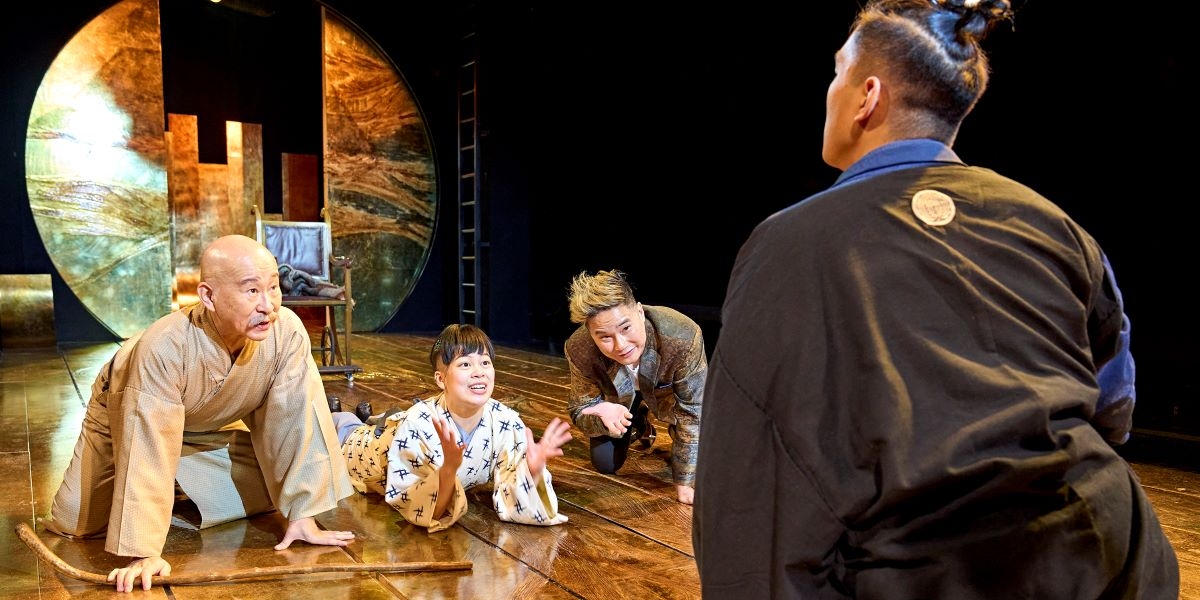‘Pacific Overtures’ was written in 1976, during Sondheim’s golden years, just after ‘A Little Night Music’ and before ‘Sweeney Todd’. However it could not be more different from its predecessor or successor, testament to the composer’s determination never to repeat himself. It has enjoyed infrequent revivals and several revisions. This production uses the chamber orchestra version from 2017, and opened in Osaka last Spring before transferring to the Menier, which has a fine reputation as a location for Sondheim revivals.
The concept and reach of the piece are vast, nothing less than the history of the transition from closed society to trading nation in nineteenth-century Japan. The bulk of the action focuses, as the ironically punning title suggests, on the ‘pacific overtures’ made by the American Commodore Perry when he arrived with four warships (‘four black dragons’) off the coast, demanding negotiations that might begin to open up Japan to Western trade and diplomacy.
The whole of this episode is viewed through Japanese eyes wrapped within an austere, minimalist musical and verbal style. The narrative focuses on the reactions of the Shogun’s court, and in particular on two of its agents, Kayama, a rapidly promoted Samurai, and Manjiro, a fisherman who has spent time in America. Their relationship parallels the social confusion and split in loyalties that the whole of Japan experiences as a result of crude Western interventions.
There are only ten musical numbers, but four of them are top-drawer Sondheim, including ‘Someone in a Tree’, his own favourite song, and a peerless meditation on the variable viewpoints of history. But for the show to work as a musical rather than a meditation then overall production values have to be spot-on; and thanks to a top-rate creative team this is unambiguously so.
There is an exceptionally beautiful set from Paul Farnsworth, both symbolic and precise. This set perfectly captures the Japanese aesthetics of eloquent gaps. We view the stage in traverse. As you enter you are hit by a tangy, rasping scent of fresh varnish on the grooved floorboards. At the start key objects in the drama are viewed by the cast in modern dress as though we were looking into a museum display. One end of the stage is closed off by an emblazoned circular double-door and the other by shifting screens framed by metal curves suggestive of abstract waves.
Costumes matter particularly as an index of the passage of both time and customs – there are lavish designs by Ayako Maeda, whether for court or foreign diplomatic ceremonial, or colourful outfits for geisha girls and sailors. The presence of the western ships is neatly referenced first by an ominous black silk hanging and then later by paper boats arranged around the midriffs of the contending diplomats (a scintillating version of the wonderful pastiche number ‘Please, Hello’) And musically things were neat, tidy and variegated, with lots of idiomatic percussion, all under the baton of Paul Bogaev.
The five lead roles were all well taken, though some of the text was not as audible as it might be. Always a danger when playing in traverse, and this is a show with a lot of dialogue. Jon Chew does a heroic job as the reciter, who is presented here as a master of ceremonies of a modern kind, shifting languages and scenes with a click of a remote. Takuro Ohno delivers a sensitive portrayal of all the phases of change in Kayama’s journey from Samurai to westernised businessman, and Joaquin Pedro Valdes takes the same pathway convincingly in reverse. Saori Oda is excellent as both the Shogun and a brothel Madam, finding dignity and humour and cunning, where needed, in each of the roles. Kanako Nakano has a small but significant role as Kayama’s wife Tamate, who is the first victim of the cultural and political upheavals.
But the success of the show rests above all in the energetic variety of the flexible ensemble, who take on multiple roles with a refined ability to sketch in a the essentials of characters – like a few brushstrokes on a paper screen.
The ambition of this show is breathtaking, and for the most part the artistic choices pay off superbly. It also help immeasurably that the action runs through without an interval, just as was the case in the recent National Theatre production of ‘Follies.’ My one doubt lies in the omission of one of the finest original numbers, ‘Crysanthemum Tea’ in the cause of preserving the pre-Perry aesthetic in the early scenes. For me this is purism taken too far. This is still a Broadway Musical in origin and authorship and there is no point pretending otherwise. This blemish apart, it is hard to see how Sondheim’s legacy could be better served than in this totally absorbing and richly rewarding production.

